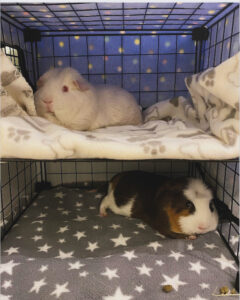What is the Best Layout for a Guinea Pig Cage? A Guide to C and C Cages for Guinea Pigs
Guinea pigs, also known as cavies, are cute, sociable pets that require a comfortable and spacious living environment to thrive. When it comes to creating the perfect home for your piggies, the layout of their cage is important. One of the most popular options among guinea pig owners is the C & C cage. This blog post will look at what makes these cages so special and how you can optimize their layout for your pet’s happiness and health.
Understanding C and C cages for Guinea Pigs
C and C cages, short for Cubes and Coroplast / correx cages, are a popular choice among guinea pig enthusiasts due to their flexibility, affordability, and spaciousness. These cages consist of wire cube grids (the ‘Cubes’) connected together to form the cage’s structure. The base of the cage is made from Coroplast / Correx (corrugated plastic), hence the second ‘C’.
One of the main advantages of these types of cages is that they allow you to customize your pet’s living space according to their needs. You can easily expand or modify them as your guinea pig family grows or their needs change.
Ideal Size for a Guinea Pig Cage
Before looking at specific layouts, it’s important to understand that size matters when it comes to guinea pig cages. The Humane Society recommends a minimum size of 7.5 square feet for one guinea pig, but as it’s always recommend to have a least a pair, you’ll need additional space.
The beauty of using c and c cages for guinea pigs is that they can be easily expanded by adding more grids. This way, you can ensure each pet has enough room to exercise and explore without feeling cramped.
Creating an Ideal Layout
When designing your guinea pig’s home, consider the following areas to create the ideal layout:
1. Sleeping Area: Guinea pigs need a cozy and quiet place to sleep. Consider placing a small hideout or hut in one corner of the cage where your pet can retreat and rest. If you have a loft, they will often choose to sleep under it, where’s it’s a bit more enclosed.

2. Feeding Zone: Dedicate a specific area of the cage for feeding. This should include a hay area, food bowl, and water bottle. Keeping these items in one place makes it easier to monitor your pet’s eating habits and maintain cleanliness.
3. Play Area: Guinea pigs are active creatures that need regular exercise to stay healthy. Include toys, tunnels, and gently sloping ramps in your layout to encourage playtime.
4. Bathroom Space: Most guinea pigs will naturally choose one area of their cage as their bathroom. Once you identify this area, place a litter box there to help contain waste and make cleaning easier.
Safety Considerations
While designing the layout of c and c cages for guinea pigs, safety should be your top priority. Ensure that the wire grids are securely connected ( using cable ties along with the connectors )to prevent any accidental collapses that could harm them. Also, make sure you only use 9×9 hole grids. There are 8×8 and 7×7 hole grids which would allow a guinea pig to get its head stuck. The 9×9 hole grids may still need baby proofing. Read more here.
Additionally, while c and c cages allow for vertical expansion (by adding lofts), it’s important to remember that guinea pigs aren’t great climbers like some other rodents. Any additional levels should be accessed via gentle ramps for safety.
Creating an ideal home for your guinea pig is not just about providing shelter; it’s about creating an environment where they can thrive physically and emotionally. C and C cages offer the flexibility and space to design a comfortable habitat that caters to all aspects of your pet’s life – from sleeping and eating areas to play zones.
Remember, every guinea pig is unique with its own personality traits and preferences. Therefore, observe your pet closely as they explore their new home. If they seem uncomfortable or unhappy, don’t hesitate to tweak the layout until it perfectly suits their needs. After all, a happy guinea pig makes for a happy piggy parent! ☺️🐹🐹


